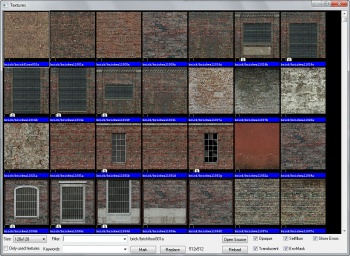Valve Dev Tool Textures
Note: It is recommended that you use the third-party tool instead. VTFEdit boasts a user-friendly interface, a wider array of accepted formats, the ability to change most VTF's properties without recompiling, a standalone viewer, and direct GCF access. Basic usage • Make sure that is running.


Texturing tools - Visual Arts. Hey all,So I've been doing quite a bit of 3. D art and I've posted a lot of it here, but my biggest problem has still been texturing. Kotaku East is your slice of Asian internet culture, bringing you the latest talking points from Japan, Korea, China and beyond. Tune in every morning from 4am to 8am. Schweser Cfa Level 3 Quicksheet Download Movies more. A texture is a two-dimensional raster image in the context of a game engine. Textures in Source are stored in the Valve Texture Format, and with a very few exceptions. Valve Dev Tool Textures Band Wiki GamesRadar+ is part of Future plc, an international media group and leading digital publisher. Linkcad 5 7 2 Keygen Free here. Visit our corporate site.
• Place the targa image to be converted inside the SteamApps/common/gamefolder/materialsrc/ folder, where gamefolder is the game folder of the current game ( cstrike/ dod/ hl2/ hl2mp/ tf). You can also place the image within a subfolder of this folder, to make Vtex compile the texture to the corresponding materials/ subfolder. (For instance, placing the image in a materialsrc/metal/ subfolder, will make Vtex compile the texture to the materials/metal/ subfolder.) • If necessary, write a containing a set of. Give it the same name as the targa image (with the exception of the.txt extension) and put it in the same folder. If you choose to omit this list, Vtex will create an empty one for you during compilation. • The Vtex executable ( Vtex.exe) is located in the /Steam/SteamApps/common/gamefolder/bin/ folder, again where gamefolder is the folder that corresponds with the target game. It can be executed in one of two ways: Through the easy 'drag-and-drop' method (described below), or the more advanced command prompt method, described.
Steam must run while it is executed. • The resulting Valve Texture File (.vtf) will be compiled to the materials/ folder of the current game by default. For instance, if the current game would be, the texture file would be compiled to the SteamApps/common/Half-Life 2/hl2/materials/ folder. If the targa image resided within a subfolder, Vtex will compile the texture file to the corresponding materials/ subfolder. If that subfolder doesn't exist, Vtex will create it automatically. The drag-and-drop method The drag-and-drop method is the easy way to use Vtex. Just drag the icon of either the targa image to be converted, or its list of compile parameters (from its materialsrc/ folder) on top of the icon of the Vtex executable ( Vtex.exe) and let go, and Vtex will compile the texture file automatically.
See also • • • • • Map editors.
Note: This is the tools/toolsblack texture, not the halflife/black texture. This texture is often used for brushes that are far away and they are dark. It cannot be lit by any type of light, but is affected by fog color. An example of its use is in the 'space' backgrounds during the G-Man monologues in Half-Life 2.